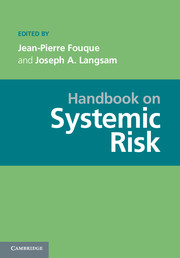Book contents
- Frontmatter
- Contents
- Contributors
- Introduction
- PART I DATA: THE PREREQUISITE FOR MANAGING SYSTEMIC RISK
- PART II STATISTICS AND SYSTEMIC RISK
- PART III MEASURING AND REGULATING SYSTEMIC RISK
- 8 Measuring Systemic Risk
- 9 Taxing Systemic Risk
- 10 Analyzing Systemic Risk of the European Banking Sector
- PART IV NETWORKS
- PART V SYSTEMIC RISK ANDMATHEMATICAL FINANCE
- PART VI COUNTERPARTY RISK AND SYSTEMIC RISK
- PART VII ALGORITHMIC TRADING
- PART VIII BEHAVIORAL FINANCE: THE PSYCHOLOGICAL DIMENSION OF SYSTEMIC RISK
- PART IX REGULATION
- PART X COMPUTATIONAL ISSUES AND REQUIREMENTS
- PART XI ACCOUNTING ISSUES
- References
10 - Analyzing Systemic Risk of the European Banking Sector
from PART III - MEASURING AND REGULATING SYSTEMIC RISK
Published online by Cambridge University Press: 05 June 2013
- Frontmatter
- Contents
- Contributors
- Introduction
- PART I DATA: THE PREREQUISITE FOR MANAGING SYSTEMIC RISK
- PART II STATISTICS AND SYSTEMIC RISK
- PART III MEASURING AND REGULATING SYSTEMIC RISK
- 8 Measuring Systemic Risk
- 9 Taxing Systemic Risk
- 10 Analyzing Systemic Risk of the European Banking Sector
- PART IV NETWORKS
- PART V SYSTEMIC RISK ANDMATHEMATICAL FINANCE
- PART VI COUNTERPARTY RISK AND SYSTEMIC RISK
- PART VII ALGORITHMIC TRADING
- PART VIII BEHAVIORAL FINANCE: THE PSYCHOLOGICAL DIMENSION OF SYSTEMIC RISK
- PART IX REGULATION
- PART X COMPUTATIONAL ISSUES AND REQUIREMENTS
- PART XI ACCOUNTING ISSUES
- References
Summary
Abstract Since the summer of 2007, the financial system has faced two major systemic crises. European banks have been at the center of both crises, particularly of the European sovereign debt crisis. This chapter analyzes the systemic risk of European banks across both crises exploiting the specific institutional nature of the European banking system. We employ the “Systemic Expected Shortfall” concept developed in Acharya et al. (2010) which creates a systemic risk index among financial institutions based on their individual contribution to the capital shortfall of the financial system.We analyze which banks are most systemic in Europe using this measure and its relationship to bank stock returns in cross-sectional tests. We then construct a systemic risk ranking of European banks and European countries as of June 2007 and calculate an estimate of the expected capital shortfall at that point of time. Our market-data based systemic risk measures suggest that markets demanded more capital from banks with high exposures to particularly peripheral countries in Europe, that is, banks’ sovereign debt holdings have been a major contributor to systemic risk. Finally, using hand-collected data of sovereign debt holdings and impairments, we provide estimates of how much capital was needed in the Fall of 2011 to restore confidence in the European banking sector.
Introduction
Since the summer of 2007, the financial system has faced two major systemic crises. While the financial crisis of 2007 to 2009 had its origin in the US housing market, the European sovereign debt crisis that started in 2010 is the result of excessive sovereign debt financed by the banking system.
- Type
- Chapter
- Information
- Handbook on Systemic Risk , pp. 247 - 282Publisher: Cambridge University PressPrint publication year: 2013
References
- 22
- Cited by



